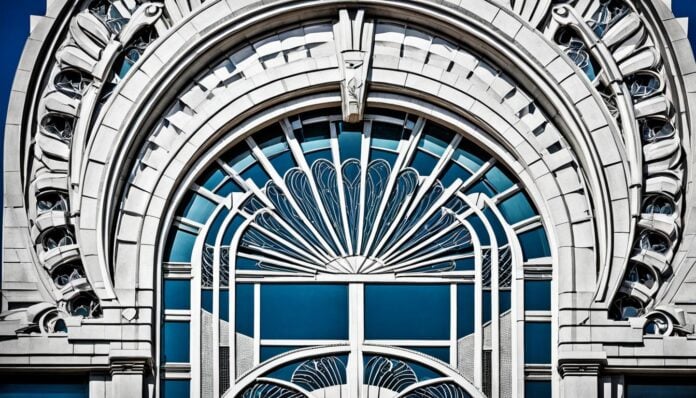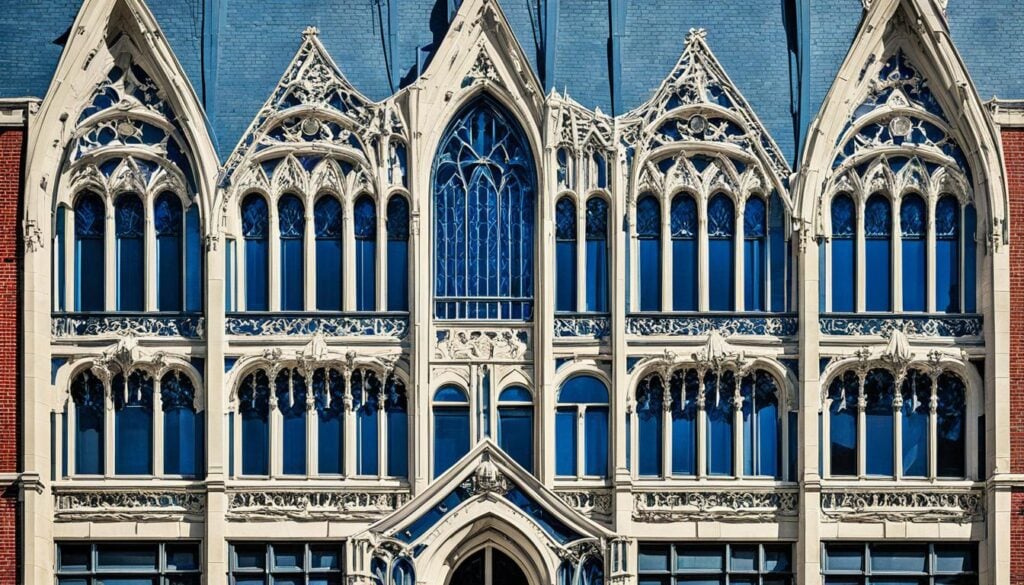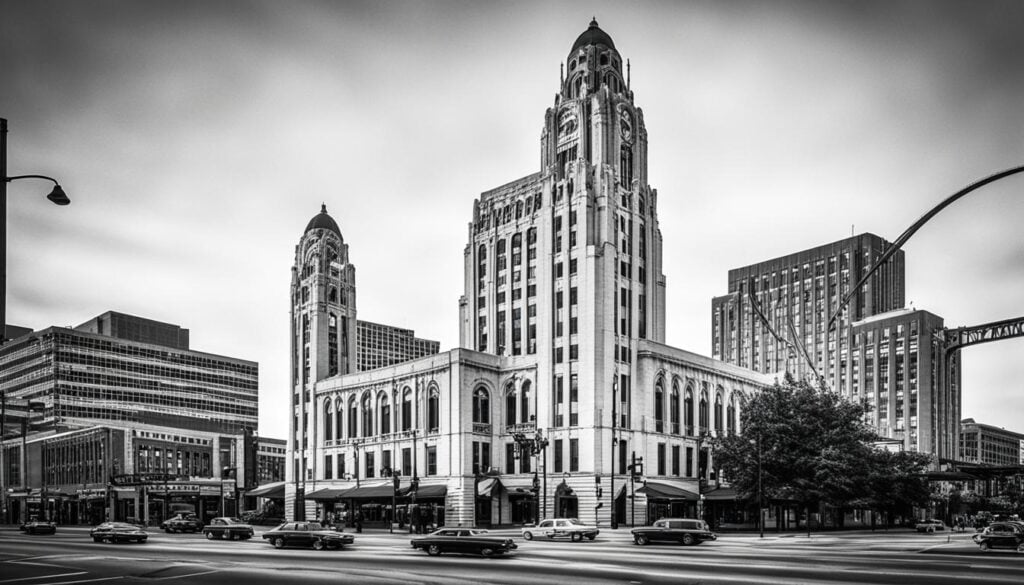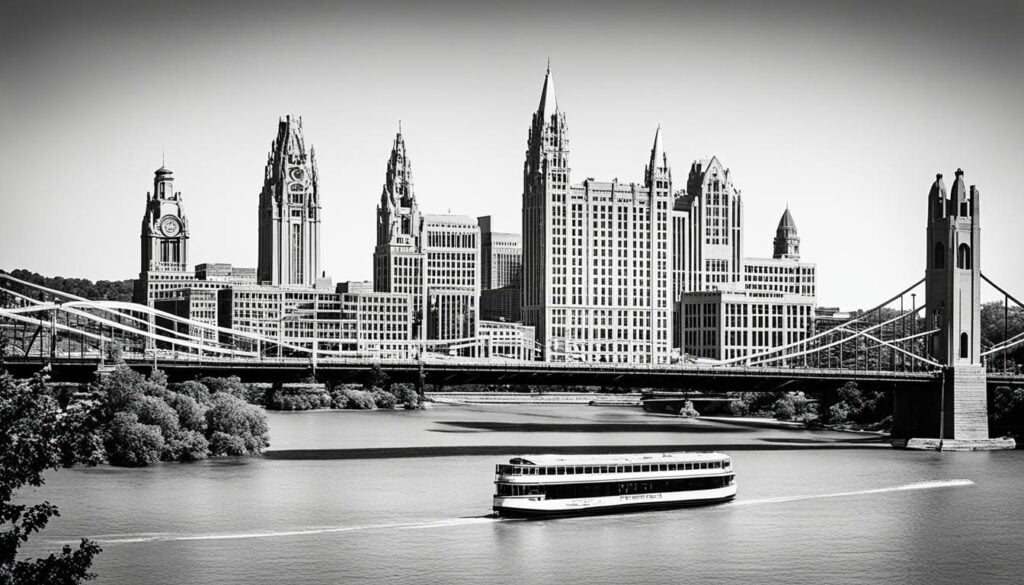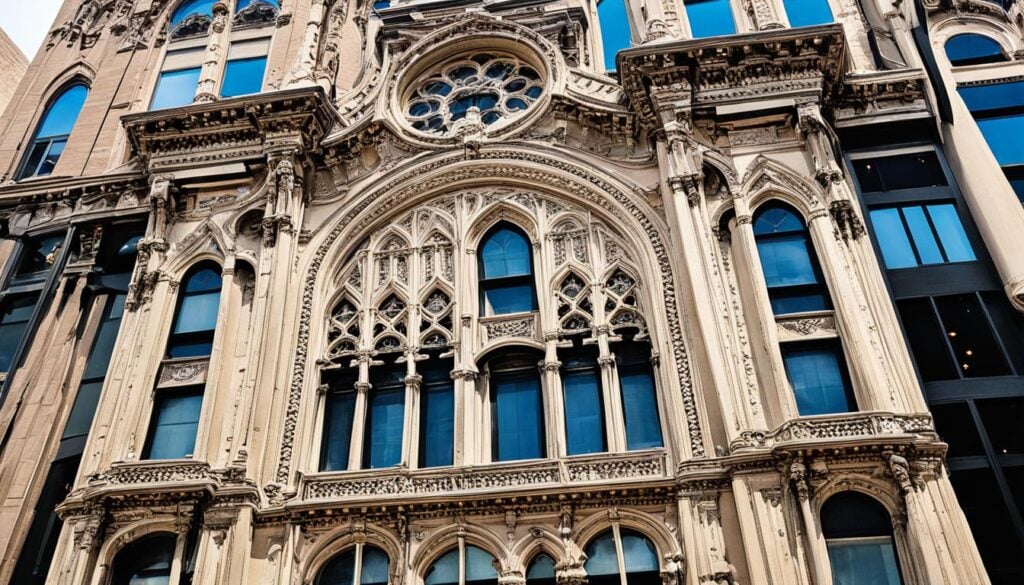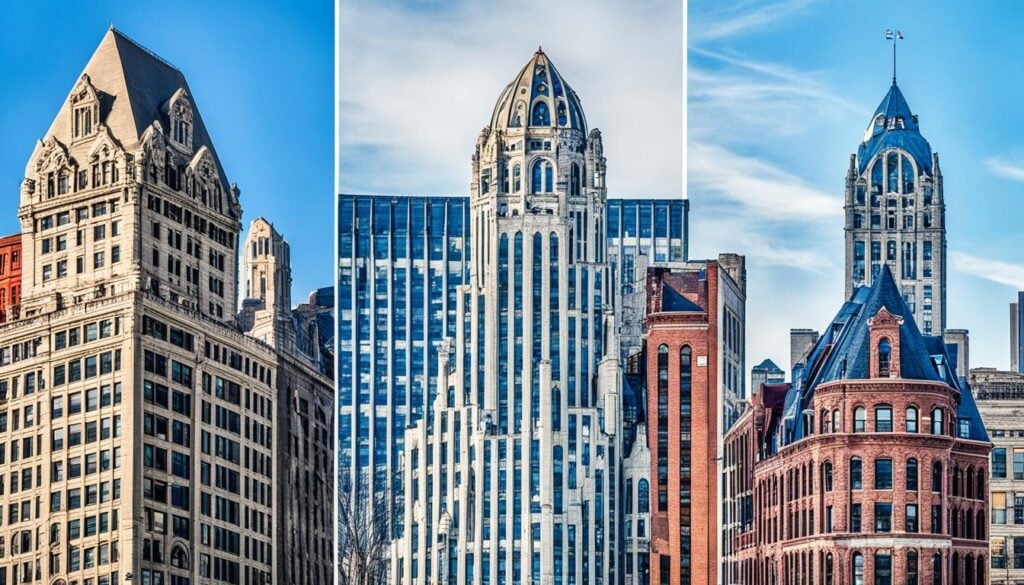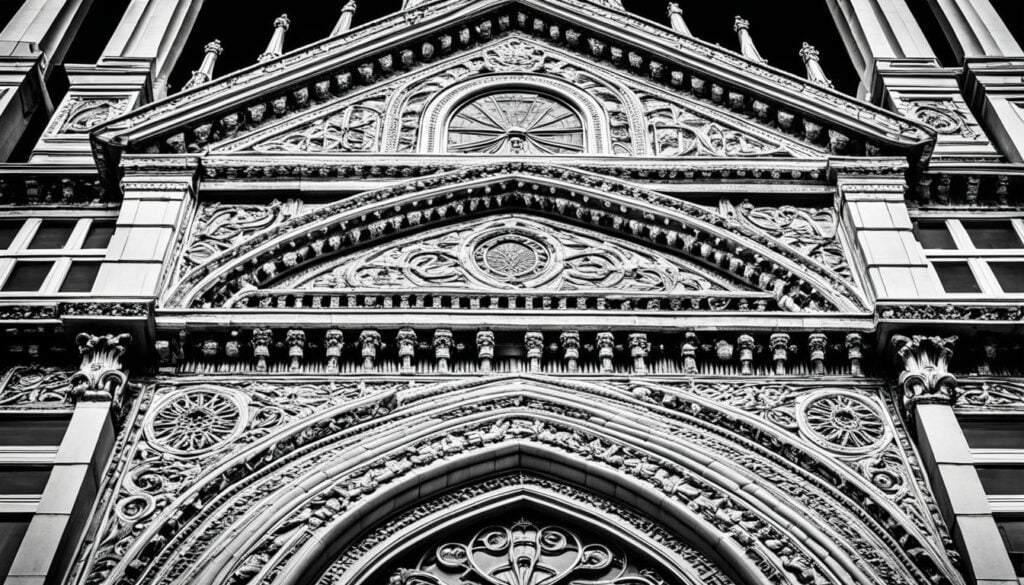Ever thought about how Cincinnati’s buildings tell the story of its past and future? As you explore Cincinnati’s architecture, you’ll see a mix of old and new. This journey shows how the city’s buildings reflect its history and its innovative spirit. You’ll learn about the styles that make Cincinnati’s skyline special, from the detailed 19th-century buildings to the modern ones.
This article will take you through Cincinnati’s architectural styles. You’ll see how these styles shape the city’s look and feel. It’s a chance to dive into the heart of Cincinnati’s design world.
Introduction to Cincinnati’s Architectural Heritage
Cincinnati’s architecture tells the story of the city’s growth from the late 18th century. It shows how the city changed over time. The diverse architectural heritage reflects different styles that have appeared over the years.
Historical events, economic changes, and cultural shifts led to these changes. They make Cincinnati a unique example of urban growth.
Cincinnati took in Cincinnati’s architectural influences from local and international sources. As it grew, new architectural styles came to life. These styles combined practicality with beauty.
This mix of styles adds to the city’s look and helps us understand modern Cincinnati.
From the classic Federal architecture to the detailed Victorian buildings, each style tells part of Cincinnati’s story. Looking at this Cincinnati architectural history shows why preserving our buildings is important. It highlights the value of the environment that shapes our lives in this great city.
| Architectural Style | Notable Features | Influences |
|---|---|---|
| Federal | Simplicity, symmetry, and brick or wood construction | Pioneering American design, influenced by Georgian styles |
| Italianate | Low-pitched roofs, tall narrow windows, and decorative brackets | Inspired by rural Italian country homes |
| Romanesque Revival | Heavy stonework, rounded arches, and intricate detailing | Medieval European architecture, particularly from France and England |
| Victorian | Intricate woodwork, vibrant colors, and asymmetrical shapes | Emergence of industrialization and mass production |
What Architectural Styles Can Be Found in Cincinnati?
Cincinnati is known for its diverse architecture that tells the city’s story. You’ll see styles like Greek Revival, Romanesque Revival, Gothic Revival, and Art Deco. Each style adds to Cincinnati’s architectural story.
The Greek Revival style is known for its big columns and looks like ancient Greek temples. You’ll see this style in public buildings, with their symmetrical shapes and big sizes.
Romanesque Revival buildings are easy to spot with their round arches and detailed carvings. This style became popular in the late 19th century in Cincinnati. It adds beauty to the city’s look.
Gothic Revival is another big style in Cincinnati. It features pointed arches and lots of details. Many churches in the city show off this style, letting us see the old craftsmanship.
Art Deco came in the early 20th century and brings a modern feel. It’s known for its geometric shapes and bright colors. This style shows how Cincinnati kept up with new design trends.
Cincinnati’s mix of architectural styles makes the city unique. Walking around or visiting historic spots, you’ll see many examples of these styles. It’s a great way to see what makes Cincinnati special.
| Architectural Style | Defining Characteristics | Common Locations |
|---|---|---|
| Greek Revival | Grand columns, pediments, symmetrical shapes | Public buildings, homes |
| Romanesque Revival | Rounded arches, intricate carvings | Neighborhood churches, municipal buildings |
| Gothic Revival | Pointed arches, detailed embellishments | Historic churches, schools |
| Art Deco | Geometric patterns, vibrant colors | Commercial buildings, theaters |
Historic Buildings That Define Cincinnati
Cincinnati’s historic buildings make the city’s skyline beautiful and tell its story. Each building shows off the city’s style and values from different times. From big theaters to unique bridges, these landmarks show off Cincinnati’s skill in building and its rich past.
Iconic Structures in the Cincinnati Skyline
The skyline of Cincinnati is marked by historic buildings that shape the city’s look. The Carew Tower stands out with its Art Deco style, and the Cincinnati Music Hall has a Gothic Revival look. The Roebling Suspension Bridge is a symbol of engineering skill and links past and present generations. These buildings show why it’s important to keep them safe for the future.
Preserving Cincinnati’s Heritage
Groups work hard to keep Cincinnati’s historic buildings safe. The Cincinnati Preservation Association is key in protecting these important buildings. They fix up old buildings, get the community involved, and support projects that use old buildings in new ways. This work keeps the buildings looking great and helps neighborhoods thrive.
Cincinnati Architectural Styles Throughout the Decades
The evolution of architectural styles in Cincinnati is fascinating. It shows how historical influences and modern trends mix. This mix helps us understand the city’s architectural identity and cultural richness. Cincinnati’s architecture has changed a lot over time, especially from the 19th century to today.
19th Century Influences
The 19th century brought new architectural styles to Cincinnati. Immigrants brought their own traditions, changing the city’s look. This led to unique designs that showed the city’s growth. Key styles from this time include:
- Victorian: Known for its intricate details and ornamental features, Victorian architecture left a lasting impression on the cityscape.
- Beaux-Arts: This style, with its grandiose features and symmetry, can still be admired in several historical buildings dotting the city.
- Gothic Revival: Popularized through churches and public buildings, this style exemplified a desire for historical consciousness.
These styles tell stories of Cincinnati’s growth during a vibrant era. They are key to understanding the city’s historical architecture.
Modern Trends in Design
Modern Cincinnati architecture focuses on sustainability and innovation. It celebrates functional aesthetics with advanced materials and technology. Modern designs highlight:
- Sustainable design: Focus on energy efficiency and environmentally friendly materials is shaping new constructions.
- Adaptive reuse: Aging structures are being revitalized, preserving their historical worth while meeting modern needs.
- Minimalist aesthetics: A shift toward simplicity has emerged, allowing spaces to breathe while maintaining elegance.
Architects are pushing boundaries, creating spaces that blend old and new. Cincinnati keeps evolving, showing a mix of its history and forward-thinking in architecture.
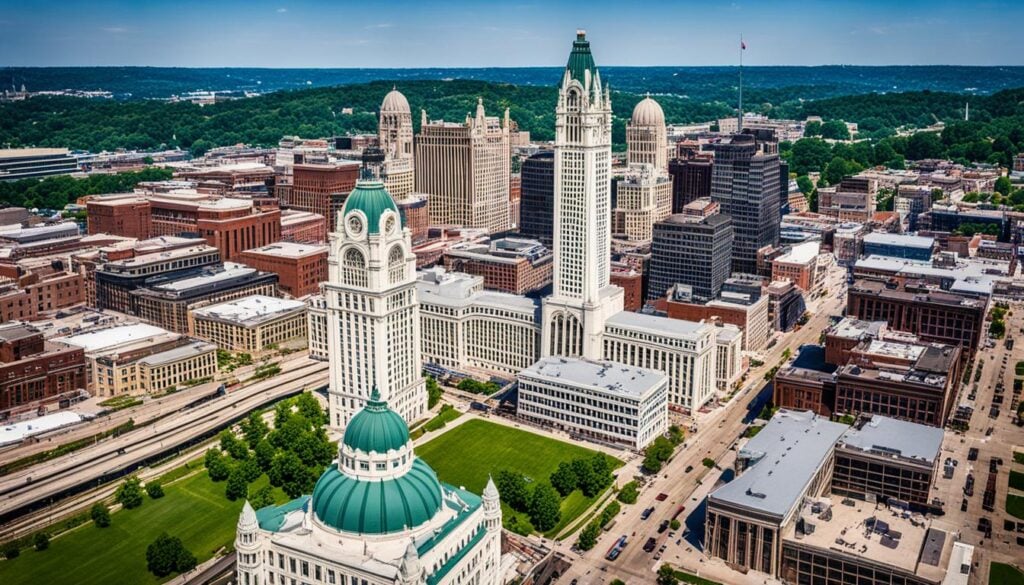
Cincinnati’s Architectural Influences from Around the World
Cincinnati’s architecture is a mix of styles from all over the world. The city’s look has changed over time, thanks to European styles. These styles have made Cincinnati’s buildings unique, combining old charm with modern looks.
European Inspirations
European styles have made a big impact on Cincinnati. You can see British, German, and Italian influences in many buildings. For example, Gothic Revival churches show off detailed craftsmanship. Italianate facades add elegance with their symmetry and smart use of materials.
These styles came from early immigrants who brought their cultural heritage to Cincinnati. They mixed their styles with the city’s own look, creating something special.
American Adaptations
Cincinnati also has its own take on architecture. This includes the Prairie School and mid-century modern styles. These styles are practical and fit well with the environment.
Local architects made these styles their own by using regional materials and thinking about the climate. This shows how Cincinnati’s architecture is a mix of old and new.
| Architectural Style | Influence Origin | Key Features |
|---|---|---|
| Gothic Revival | Europe, primarily Britain | Pointed arches, intricate facades, and detailed stonework |
| Italianate | Europe, particularly Italy | Wide eaves, tall windows, and decorative brackets |
| Prairie School | United States | Horizontal lines, flat or hipped roofs, and natural materials |
| Mid-Century Modern | United States | Open spaces, integration with nature, and clean lines |
Cincinnati’s architecture shows how the city values its history and creates new stories. The mix of European and American styles makes Cincinnati’s buildings diverse and rich.
The Role of Urban Planning in Cincinnati’s Architecture
Urban planning plays a big part in shaping Cincinnati’s architecture. It includes zoning laws, development plans, and understanding historical trends. This mix helps Cincinnati’s architecture evolve over time. Urban planners work together to blend new designs with the city’s old look.
Influencing Growth and Development
Cincinnati is growing, and smart urban planning is key to its growth. This has led to projects that make neighborhoods lively again while keeping their history. Planners think about what makes Cincinnati special and what it needs for the future.
Notable Urban Projects
Cincinnati has some big projects that show its focus on smart architecture. For example, Over-the-Rhine’s renewal keeps its history but adds new life. The Banks is another example, blending business and living spaces by the river.
Here’s a look at some key projects:
| Project Name | Description | Architectural Features | Completion Year |
|---|---|---|---|
| Over-the-Rhine Revitalization | Restoration of historic buildings to create a cultural hub. | Preserved facades with modern interiors. | 2012 |
| The Banks | Development along the riverfront with mixed-use spaces. | Contemporary designs with public plazas. | 2015 |
| Cincinnati Streetcar | Streetcar line connecting neighborhoods and downtown. | Modern and efficient transit design. | 2016 |
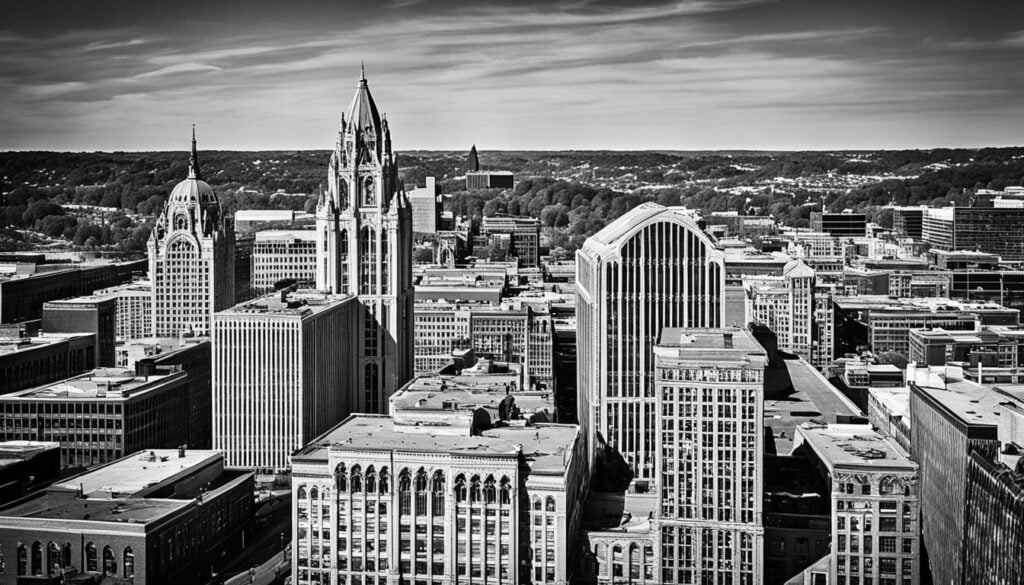
Discovering Cincinnati’s Architectural Diversity
Cincinnati is a city that shows the big impact of multicultural influences on its buildings. It has architectural styles in different Cincinnati communities. Places like Northside, Clifton, and Avondale each have their own look and story. These areas make the city’s architecture rich and varied.
Styles Representing Different Communities
In Cincinnati, buildings tell the story of the city’s history. Let’s look at some key areas and their unique architectural features:
- Northside: It’s known for Victorian and Arts and Crafts styles, showing a free-spirited vibe.
- Clifton: This area has Gothic Revival and Tudor homes, giving it a scholarly feel.
- Avondale: It’s famous for Colonial and Neoclassical buildings, symbolizing its wealthy history.
The architectural styles in different Cincinnati communities show more than just beauty. They tell us about the social stories of these places.
Mix of Old and New Designs
Cincinnati’s mix of old and new buildings is truly eye-catching. The city’s approach to blending old and new architecture in Cincinnati is clear in many buildings. This mix helps create architectural cohesion through:
- Restoration Projects: Historic buildings are updated for modern use but keep their original looks.
- New Developments: New buildings often take cues from the past, adding to the city’s story.
- Innovative Materials: Projects use modern materials like glass and steel alongside traditional ones like brick and stone for a unique look.
Cincinnati keeps evolving as a place where history and innovation meet. It’s a city that respects its past while embracing the future.
Cincinnati Landmark Architecture You Must See
Cincinnati is full of landmark architecture that tells the city’s story. From the modern Great American Ball Park to the elegant Cincinnati Art Museum, these spots are a must-see. Each one has its own story, showing off the city’s culture and history.
Prominent Landmarks and Their Stories
Every landmark in Cincinnati has its own story. The Cincinnati Art Museum is known for its art and neoclassical design. It has grand columns and intricate details. On the other hand, the Great American Ball Park is modern, blending new features with Cincinnati’s baseball history.
- Cincinnati Art Museum: A blend of historical and contemporary architecture.
- Great American Ball Park: A striking example of modern stadium design.
- Carew Tower: Iconic Art Deco skyscraper with breathtaking city views.
- Findlay Market: Historic market showcasing a vibrant blend of architectural styles.
- Music Hall: Renowned for its stunning Gothic Revival architecture.
Architectural Features of Cincinnati’s Landmarks
Cincinnati’s landmarks are known for their unique design elements. You’ll see decorative facades, striking domes, and ornate columns. These details make each building stand out and tell its story.
| Landmark | Architectural Style | Signature Features | Cincinnati Landmark Details |
|---|---|---|---|
| Cincinnati Art Museum | Neoclassical | Columns, Pediments | Home to over 67,000 artworks |
| Great American Ball Park | Modern | Open concourse, LED displays | Offers stunning views of the Ohio River |
| Carew Tower | Art Deco | Spired rooftop, Geometric designs | Second tallest building in Cincinnati |
| Findlay Market | Romanesque Revival | Brick arches, Colorful awnings | Ohio’s oldest continuous market |
| Music Hall | Gothic Revival | Pointed arches, Stained glass | Listed on the National Register of Historic Places |
Conclusion
Cincinnati’s architecture is a mix of old and new styles. It shows how each time period has added to the city’s look and feel. This mix makes the city’s skyline and neighborhoods lively and diverse.
Looking at Cincinnati’s buildings gives us a peek into its growth and identity. You’ll see everything from Gothic Revival churches to modern buildings. Each one has its own story, showing what the community values and dreams of.
Keeping Cincinnati’s old buildings is important. It’s about valuing the skill and creativity in our surroundings. As you keep exploring, you’ll see how every part of the city adds to its special place in American architecture. It’s a living tribute to its past and future.

































